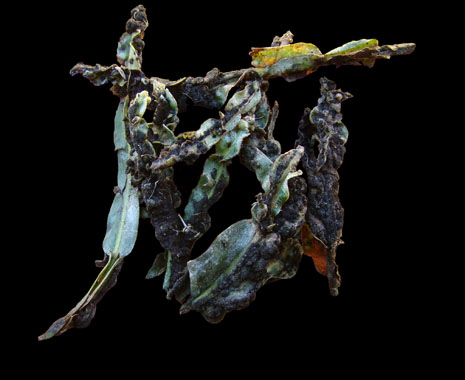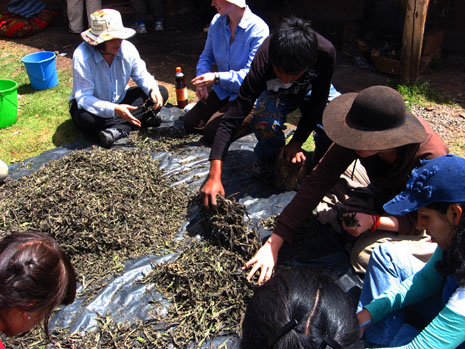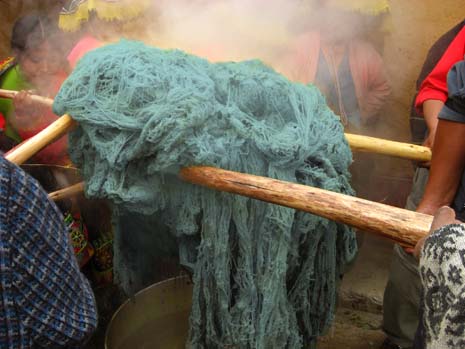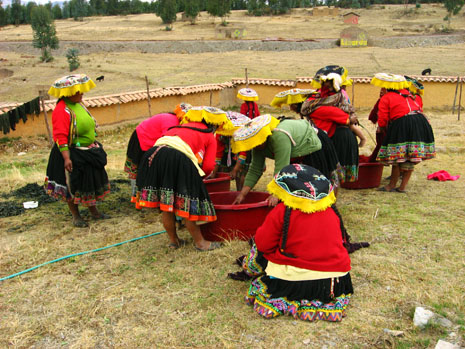Kinsa Q'uchu: A Substantive Peruvian Dye
By Katie Vota
Kinsa Q'uchu (Baccharis genistelloides, from the family Asteraceae) is a plant of many names. In Spanish it is Carqueja or Carkeja. In its native Quechua, it's kinsa q'uchu or quinsak'ucho. Kinsa q'uchu means "three corners" in Quechua, because the shape of the leaf is composed of three flat sections radiating out from the stem. The tri-cornered leaves grow straight up from the root, reaching a height of about 14"-16". Kinsa q'uchu is found in the north-eastern part of the Cusco region of the Andes, a desert climate region that borders the jungle, with an altitude between 3000-4000m. Locals from communities nearby, such as Parobamba and Bombón, walk down the hillsides below their villages looking for the plant, which grows in small clusters. They gather and dry it and take it to other communities to sell or trade for items like alpaca wool.

The first time I encountered this plant was at the annual dye workshop that the Center for Traditional Textiles of Cusco (CTTC) hosts in Chinchero, Peru every fall.1 As a recently awarded Fulbright Grantee, I had been in Peru exactly two weeks, only one of which I'd actually spent working with the CTTC, and suddenly I was in Chinchero, immersed in Andean natural dyes up to my eyeballs. We dyed from sun-up to sundown, achieving a myriad of colors—from golden yellows, peaches, and oranges to reds, purples, greens, and blues. The most fascinating of the dyes, however, was the kinsa q'uchu, giving us teal blue and turquoise. Even with indigo, I've never achieved these colors without over-dyeing.

There are two ways to dye with kinsa q'uchu, and they have to do with the fungus that grows on its leaves. Without the fungus, kinsa q'uchu can be used to obtain yellows and olive greens when you add a ferrous sulfate assist (found either in the volcanic rock of the region or in the iron rich clays).2 However, the sought-after turquoise-giving dye properties of kinsa q'uchu are found in the black fungus that grows on its leaves. For that, only leaves affected by the black fungus are collected for dyeing. The fungus is what provides the dyestuff and the tannic acid-rich leaves of the plant act as the mordant for the fungus growing on it. The ratio of dyestuff to fiber is 1:1, as long as there's a lot of fungus on the plant. Otherwise it's 2:1 dyestuff to fiber.
To prepare the kinsa q'uchu for dyeing, it must first be harvested and dried. The plant is hardy and can be harvested at any point during the year. Once dry, the stalks are either chopped into small, approximately 1/2" pieces, or ground, which is better but isn't particularly practical for large dye vats. The largest pots I've seen used hold 80 liters water and can dye up to 20 pounds of yarn at a time, and grinding 20 pounds of kinsa q'uchu is really just excessive.

Once the dyestuff is prepared, the water is heated over traditional wood-fire stoves called q'uncha. During this time the yarn is scoured and sorted by the color it will become. When the water is warm, the kinsa q'uchu is added and stirred in. Just before the water boils, the clean, fully wetted yarn is added and stirred vigorously. The pot is kept at a hard boil for 30 minutes to 1 hour, depending on the desired depth of shade, and is stirred frequently to get the most even color. Once the desired shade of turquoise is obtained, the pot is removed from the heat. A group of weavers with long stout sticks hoist the yarn out of the dye pot and hold it there, overtop to drip, before setting the yarn aside in a tub to cool.

When the yarn is cool enough to handle, it is separated by skeins and the pieces of kinsa q'uchu are shaken out of it before it is left to cool before washing. The washing process usually takes 3 tubs of water that are for the progressively cleaner yarn. The weavers form something like an assembly line, passing the yarn from one tub to another until the water runs clear from the yarn. Then the skeins are usually left to dry on nearby fences or clotheslines, while the vat is placed back on the q'uncha stove and is used for 2-4 exhaust dyes, or until the weavers run out of yarn, obtaining progressively lighter turquoises and grey-teals. Often, these exhaust dyes are mixed with other exhaust dyes to obtain an even broader spectrum of colors.

1 The Center for Traditional Textiles of Cusco (CTTC) is a non-profit, based out of Cusco, Peru, that is working to facilitate the education of young weavers in Andean textile traditions of the Cusco region, as well as enabling Andean weavers from the region to make a living off their weaving, by receiving fair-trade value for their work. For more information, please check out their website: www.textilescusco.org.
2 Roquero, Ana, 2006. Tintes y tintoreros de America: Catalogo de materias primas y registro etnografico de Mexico, Centro America, Andes Centrales y Selva Amazonica. Madrid: Ministerio de Cultura. p. 109.
 Turkey Red Journal
Turkey Red Journal
